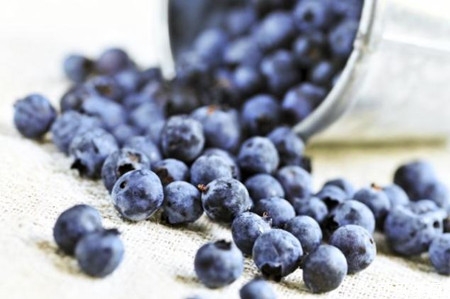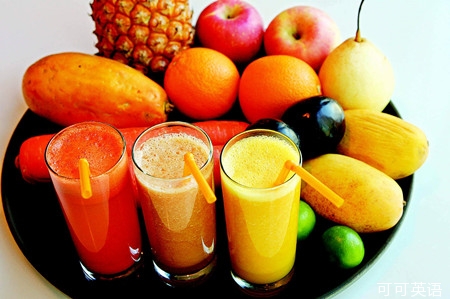(单词翻译:单击)

People who ate at least two servings per week of whole fruits like blueberries, grapes and apples reduced their risk of Type 2 diabetes by up to 23%, according to research. But those who drank one or more servings of fruit juice each day increased their diabetes risk by roughly the same amount.
根据相关研究,如果每周吃两次以上蓝莓、葡萄、苹果等水果,可以降低23%患2型糖尿病病的风险。然而,您要是天天喝果汁来代替吃水果的话,效果可就适得其反,会增加23%左右患糖尿病病的风险。
Eating whole fresh fruit, especially blueberries, grapes, apples and pears, is linked to a lower risk of Type 2 diabetes, but drinking fruit juice has the opposite effect, says a new study.
最新研究显示,吃水果,特别是蓝莓、葡萄、苹果核梨子等水果会降低患2型糖尿病风险,而喝果汁却会适得其反。
British, U.S. and Singaporean researchers pored over data from three big health investigations that took place in the United States, spanning a quarter of a century in all.
英国、美国和新加坡的研究员们共同就相关问题展开研究,以美国人的健康状况为研究对象,历时四分之一个世纪,针对三项大的健康调查得出数据。
More than 187,000 nurses and other professional caregivers were enrolled.
这项研究共有超过187000的护士和健康从业人员参加。
Their health was monitored over the following years, and they regularly answered questionnaires on their eating habits, weight, smoking, physical activity and other pointers to lifestyle.
研究过程中,志愿者的健康情况受到监控。他们还会定时完成关于饮食习惯、体重变化、是否吸烟、运动习惯等与健康相关的调查问卷。
Around 6.5 percent of the volunteers developed diabetes during the studies.
参与调查的志愿者中,有大约百分之6.5的志愿者在研究过程中被检测到患上了糖尿病。
People who ate at least two servings each week of certain whole fruits, especially blueberries, grapes and apples, reduced their risk of Type 2 diabetes by as much as 23 percent compared to those who ate less than one serving per month.
在被研究对象里,有习惯一周吃两次以上水果,特别是蓝莓、葡萄和苹果等水果的志愿者,相比那些一个月甚至更久都不吃水果的志愿者,减小了23%患2型糖尿病的风险。
"Our findings provide novel evidence suggesting certain fruits may be especially beneficial for lower diabetes risk," said Qi Sun, an assistant professor of nutrition at the Harvard School of Public Health.
哈弗大学副教授Qi Sun告诉我们:“我们的研究发现,一些水果确实可以降低患糖尿病的几率。”
On the other hand, those who consumed one or more servings of fruit juice each day saw their risk of the disease increase by as much as 21 percent.
然而,那些每天都喝一杯或更多果汁的人却增加了至少21%患糖尿病的几率。
Swapping three servings of juice per week for whole fruits resulted in a seven-percent reduction in risk, although there was no such difference with strawberries and cantaloupe melon.
如果一周只喝三次果汁,患糖尿病的几率会相对减小7%。所饮用果汁的种类,无论是草莓还是哈密瓜果汁或是其他水果汁,其结果没有区别。
The paper, published on Friday by the British Medical Journal (BMJ), says further work is needed to to explore this "significant" difference.
这个研究的结果周五发表在英国的医学期刊上。文章中提到,会继续探食用水果和饮用果汁的之间的区别。
It speculates that, even if the nutritional values of whole fruit and fruit juice are similar, the difference lies with the fact that one food is a semi-solid and the other a liquid.
研究指出,水果和果汁的营养成分是近似的,唯一不同的是前者是半固体形态,后者是液体形态。
"Fluids pass through the stomach to the intestine more rapidly than solids even if nutritional content is similar," says the paper.
“尽管果汁和水果的营养成分近似,然而果汁从胃到肠子的时间更快。”文章中提到。
"For example, fruit juices lead to more rapid and larger changes in serum [blood] levels of glucose and insulin than whole fruits."
The study also points to evidence that some kinds of fruit have a beneficial effect for health.
“果汁在迅速通过肠胃时引起血糖和胰岛素的变化比吃水果所引起的血糖和胰岛素的变化更为显著。”
Berries and grapes, for instance, have compounds called anthocyanins which have been found to lower the risk of heart attacks.
比如,莓类水果以及葡萄含一种叫做花青素的物质可以降低心脏病的几率。
But, say the authors, how or even whether this also applies to diabetes risks is for now unclear.
然而根据作者所述,这类水果是否会导致糖尿病病,怎样的情况下会导致糖尿病至今还不是很清楚。
本译文属可可原创,未经允许请勿转载


